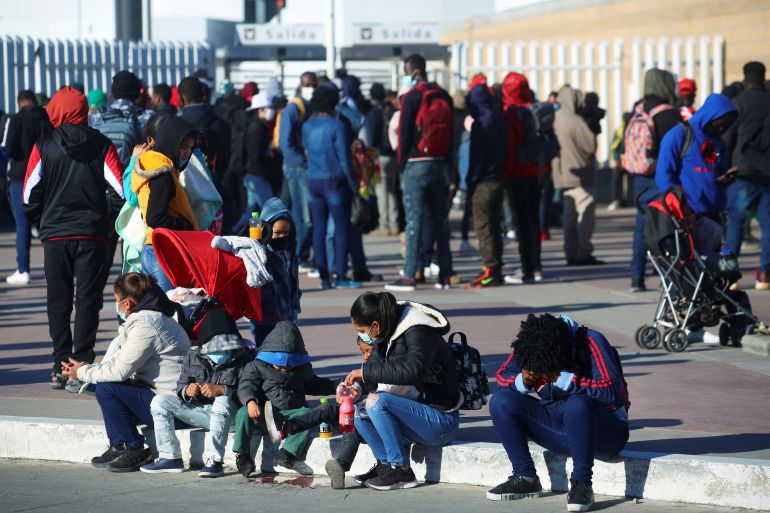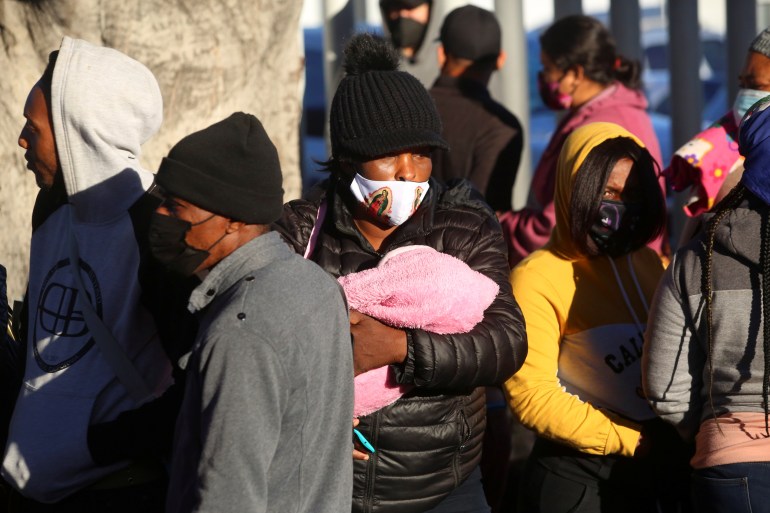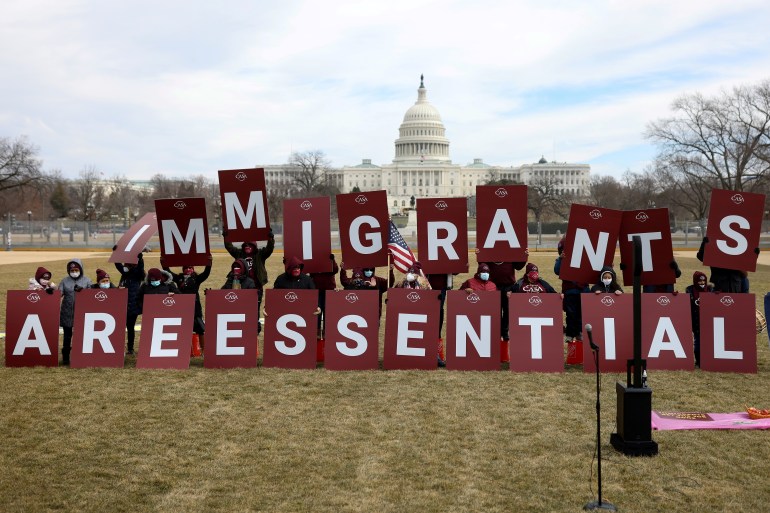First batch of asylum seekers waiting in Mexico allowed into US
In a reversal of a Trump-era policy, more than 25,000 asylum seekers will be allowed to pursue their claims in the US.

Twenty-five people who were forced to wait in Mexico while their asylum claims were being processed were allowed into the United States on Friday, after the reversal of an immigration policy put in place by former President Donald Trump.
The asylum seekers crossed through the San Ysidro crossing in San Diego, California and are part of a group of more than 25,000 people who were subject to the Migrant Protection Protocols (MPP) programme – which required migrants to wait in Mexico often under dangerous conditions.
Keep reading
list of 3 items‘Sigh of relief’: Immigration advocates welcome Biden proposal
US-bound caravan faces hunger, Biden plans immigration reform
Now, the administration of President Joe Biden, which has been dismantling Trump’s hardline anti-immigration legacy, said applicants will be able to pursue their claims in the US.

“These people were pre-selected by the United Nations High Commissioner for Human Rights (UNHCR) as being particularly vulnerable and they were the first people to be processed,” Taylor Levy, an immigration lawyer based in California who represents asylum seekers in Mexico, told Al Jazeera.
“Moving forward people will need to register on the UNHCR portal and then processing will be done primarily on the basis of when people were put into MPP,” Levy said.
Starting on Monday, small groups of asylum seekers will begin entering through the Brownsville, Texas port of entry, according to the State Department, and on February 26, into El Paso, Texas. Gradually, officials have said the number of entrants is expected to eventually reach 300 a day through each port.
DHS has partnered with international organisations, the UN refugee agency UNHCR and the International Organization for Migration (IOM) to register asylum seekers through an online and phone system which is due to go live on Friday, in order to identify the most vulnerable cases as well as those who have been waiting the longest. The organisations will also test the asylum seekers for the coronavirus in Mexico.

Trump’s legacy
Trump put in place the MPP or the “Remain in Mexico” programme two years ago, arguing the policy was necessary to put an end to the exploitation of asylum law.
Under the procedure more than 65,000 people, a third of them children were sent to six cities and towns along the US-Mexico border, most of which are controlled by drug cartels and where rights groups said asylum seekers were subject to abduction, robbery, and sexual violence.
Over 1,000 people live in the makeshift Matamoros camp across the border from Brownsville, Texas, whose squalid conditions were made even worse by recent frigid temperatures.
Human Rights First organisation based in Washington, DC, has documented 1,544 attacks against MPP asylum seekers from February 2019 through February 2021, including 341 kidnappings or attempted kidnappings of children.
The announcement made last week, brought a great deal of relief for Juan, 29, who has been waiting in Mexico under the programme for a year and a half, with his wife and their five-year-old daughter.
“I felt so happy, I have hope that I won’t have to live in Mexico anymore, and continue to live under this constant danger,” Juan who fled political persecution in Venezuela under the Maduro regime tells Al Jazeera.
While waiting to plead his claim he said Mexican cartels tried to kidnap his daughter for extortion money, and on a different occasion, a vehicle with armed men followed them. Nuevo Laredo, the city where he was bussed to by immigration authorities, was so dangerous, he said that he decided to move to Monterrey, a city about three hours south.
Because of the coronavirus pandemic, their asylum hearing has been postponed three times. Meanwhile, Juan, who once worked as an auto mechanic in Venezuela, has no health insurance or permission to work in Mexico. And their daughter cannot attend school. He said he found some work at a restaurant where he makes $0.40 an hour – not enough to feed his family, so he relies on money his sister who lives in the US, sends him.
“I just want to feel safe, go to work without fear that someone would rob me or kidnap me,” Juan said.

Significant reversal
Human rights advocates have welcomed the reversal, saying it is an important first step, but added that it may not be enough to undo a policy that inflicted a great deal of harm on asylum seekers and denied protection to people fleeing from violence in their home countries.
“This phase one is a very good step, we’re very encouraged to see this, and we’re encouraged by the inclusion of international organisations in the implementation rollout,” said Daniella Burgi-Palomino, co-director of the Latin America Working Group, an immigration rights group based in Washington, DC.
“This policy forced asylum seekers including families with children to wait in dangerous border towns across Mexico’s northern border without any support whatsoever,” she told Al Jazeera.
“It left them to fend for themselves to find a lawyer, to find shelter, to find any sort of support in towns and cities that they didn’t know had organised crime, where law enforcement is corrupt,” she said.
Advocates of Trump’s programme have said it was an effective policy that deterred people who wanted to migrate to the United States using frivolous asylum claims.
“The MPP policy was probably the most important policy that led to resolving a crisis in 2019 when we saw record numbers of people coming with families and kids to try to take advantage of US policies,” said Jessica Vaughan, director of policy studies at the Center for Immigration Studies, a research group that advocates for decreasing immigration to the US.
Biden’s policy is “a very significant reversal”, Vaughan told Al Jazeera.

On Thursday, Congressional Democrats released a comprehensive immigration bill that includes an eight-year pathway to citizenship for the nearly 11 million undocumented immigrants living in the US. The White House has acknowledged that change will take time.
“The situation at the border will not transform overnight, due in large part to the damage done over the last four years,” the White House said in a February 2 factsheet. “But the President is committed to an approach that keeps our country safe, strong, and prosperous and that also aligns with our values,” according to the document.
Pro-immigration advocates, meanwhile, said the US border remains essentially closed for new asylum seekers and the Biden administration continues to employ the “Title 42” immigration rule, a provision invoked by the Trump administration that used the pretence of the pandemic to swiftly expel people who seek asylum at a US port of entry, even if they are fleeing danger.
“While this is a huge step, the border does remain essentially shut down for all new asylum seekers,” says Becky Gendelman, an attorney at Human Rights First who represents Juan and his family.
“People continue to be expelled under the government’s misuse of public health authority under Title 42, so asylum seekers continue to be either pushed back to Mexico or summarily removed to the country where they fled persecution.”